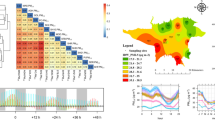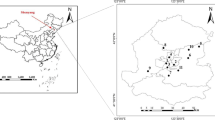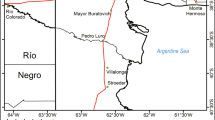Abstract
An integrated approach to understanding all measured pollutants with multi-discipline in different time scales and understanding the mechanisms hidden under low air quality (AQ) conditions is essential for tackling potential air pollution issues. In this study, the air pollution of Sivas province was analyzed with meteorological and PM2.5 data over six years to assess the city’s AQ in terms of PM2.5 pollution and analyze the effect of meteorological factors on it. It was found that the winter period (January–February-November–December) of every year except 2019—which has missing data—is the period with the highest air pollution in the province. In addition, the days exceeding the daily PM2.5 limit values in 2016, 2017, 2020, and 2021 were also seen in the spring and summer months, which inclined the study to focus on additional pollutant sources such as long-range dust transport and road vehicles. The year 2017 has the highest values and was analyzed in detail. Pollution periods with the most increased episodes in 2018 were analyzed with the Hybrid Single-Particle Lagrangian Integrated Trajectory (HYSPLIT) and Dust Regional Atmospheric Model (DREAM) models. As a result of the study, the average PM2.5 values in 2017 were 31.66 ± 19.2 µg/m3 and a correlation of −0.49 between temperature and PM2.5. As a result of model outputs, it was found that the inversion is intensely observed in the province, which is associated with an increase of PM2.5 during the episodes. Dust transport from northwestern Iraq and northeastern Syria is observed, especially on days with daily average PM2.5 values above 100 µg/m3. Additionally, planetary boundary layer (PBL) data analysis with PM pollution revealed a significant negative correlation (r = −0.61). Air pollutants, particularly PM2.5, were found to be higher during lower PBL levels.










Similar content being viewed by others
Availability of data and material
Study Area Data: Turkish Statistical Institute (TURKSTAT). (2023b). https://www.tuik.gov.tr/. Accessed on 17 January 2023. Meteorological Station Data: Turkish State Meteorology Service. PM2.5 Monitoring Data: The Ministry of Environment, Urbanization, and Climate Change developed two different AQ Monitoring Stations.
References
Çapraz, Ö., & Deniz, A. (2021). Particulate matter (PM10 and PM2. 5) concentrations during a Saharan dust episode in Istanbul. Air Quality, Atmosphere & Health, 14(1), 109–116.
Çapraz, Ö., Deniz, A., & Doğan, N. (2017). Effects of air pollution on respiratory hospital admissions in İstanbul, Turkey, 2013 to 2015. Chemosphere, 181, 544–550.
Çapraz, Ö., Efe, B., & Deniz, A. (2016). Study on the association between air pollution and mortality in İstanbul, 2007–2012. Atmospheric Pollution Research, 7(1), 147–154.
Draxler, R. R. (1982). Measuring and modeling the transport and dispersion of kRYPTON-85 1500km from a point source. Atmospheric Environment (1967), 16(12), 2763–2776.
Draxler, R. R., & Hess, G. D. (1998). An overview of the HYSPLIT_4 modelling system for trajectories. Australian Meteorological Magazine, 47(4), 295–308.
Efe, B., Öztaner, Y. B., Deniz, A., & Unal, A. (2022). Analysis of air pollutants in Kagithane valley and Istanbul Metropolitan Area. Air Quality, Atmosphere & Health, 1–15.
Environment, SA. Available online: http://www.environnement-sa.com/ . Accessed on 01 Jan 2023.
Environmental Protection Agency (USEPA). (2022). https://www.epa.gov/pm-pollution/particulate-matter-pm-basics. Accessed on 17 Jan 2023.
Flores, R. M., Özdemir, H., Akkoyunlu, B. O., Ünal, A., & Tayanç, M. (2020). Seasonal variation of carbonaceous PM2. 5 in an Istanbul traffic site. Atmospheric Pollution Research, 11(12), 2110–2118.
Fortelli, A., Scafetta, N., & Mazzarella, A. (2016). Influence of synoptic and local atmospheric patterns on PM10 air pollution levels: A model application to Naples (Italy). Atmospheric Environment, 143, 218–228.
Galindo, N., Varea, M., Gil-Moltó, J., Yubero, E., & Nicolás, J. (2011). The influence of meteorology on particulate matter concentrations at an urban Mediterranean location. Water, Air, & Soil Pollution, 215(1), 365–372.
Gheibi, M., Taghavian, H., Moezzi, R., Waclawek, S., Cyrus, J., Dawiec-Lisniewska, A., ... & Khaleghiabbasabadi, M. (2023). Design of a decision support system to operate a NO2 gas sensor using machine learning, sensitive analysis and conceptual control process modelling. Chemosensors, 11(2), 126.
Ghorani-Azam, A., Riahi-Zanjani, B., & Balali-Mood, M. (2016). Effects of air pollution on human health and practical measures for prevention in Iran. Journal of research in medical sciences: the official journal of Isfahan University of Medical Sciences, 21.
He, J., Gong, S., Yu, Y., Yu, L., Wu, L., Mao, H., ... & Li, R. (2017). Air pollution characteristics and their relation to meteorological conditions during 2014–2015 in major Chinese cities. Environmental pollution, 223, 484–496.
Ilker, O. R. U. C. (2022). Long-range transport and potential source regions of PM2. 5 during the autumn season in Edirne, Türkiye. Frontiers in Life Sciences and Related Technologies, 3(3), 95–100.
Kabatas, B., Pierce, R. B., Unal, A., Rogal, M. J., & Lenzen, A. (2018). April 2008 Saharan dust event: Its contribution to PM10 concentrations over the Anatolian Peninsula and relation with synoptic conditions. Science of the Total Environment, 633, 317–328.
Karakuş, C. B., & Yildiz, S. (2019). Hava kalite indeksi ile meteorolojik parametreler arasindaki ilişkinin çoklu regresyon yöntemi ile belirlenmesi. Niğde Ömer Halisdemir Üniversitesi Mühendislik Bilimleri Dergisi, 8(2), 698–711.
Kelly, F. J., & Fussell, J. C. (2015). Air pollution and public health: Emerging hazards and improved understanding of risk. Environmental Geochemistry and Health, 37(4), 631–649.
Kiyan, A., Gheibi, M., Akrami, M., Moezzi, R., & Behzadian, K. (2023). A comprehensive platform for air pollution control system operation in smart cities of developing countries: A case study of Tehran. Environmental Industry Letters, 1(1), 10–27.
Laña, I., Del Ser, J., Padró, A., Vélez, M., & Casanova-Mateo, C. (2016). The role of local urban traffic and meteorological conditions in air pollution: A data-based case study in Madrid, Spain. Atmospheric Environment, 145, 424–438.
Li, Y., Hoi, K. I., Mok, K. M., & Yuen, K. V. (2023). Air quality monitoring and advanced Bayesian modeling. Elsevier.
Ma, Y., Wang, M., Wang, S., Wang, Y., Feng, L., & Wu, K. (2021). Air pollutant emission characteristics and HYSPLIT model analysis during heating period in Shenyang. China. Environmental Monitoring and Assessment, 193(1), 1–14.
Manisalidis, I., Stavropoulou, E., Stavropoulos, A., & Bezirtzoglou, E. (2020). Environmental and health impacts of air pollution: A review. Frontiers in Public Health, 14.
Matthias, V., Arndt, J. A., Aulinger, A., Bieser, J., Denier van der Gon, H., Kranenburg, R., ... & Quante, M. (2018). Modeling emissions for three-dimensional atmospheric chemistry transport models. Journal of the Air & Waste Management Association, 68(8), 763–800.
Mehmood, U., Azhar, A., Qayyum, F., Nawaz, H., Tariq, S., & Haq, Z. U. (2021). Air pollution and hospitalization in megacities: Empirical evidence from Pakistan. Environmental Science and Pollution Research, 28(37), 51384–51390.
Nickovic, S., Kallos, G., Papadopoulos, A., & Kakaliagou, O. (2001). A model for prediction of desert dust cycle in the atmosphere. Journal of Geophysical Research: Atmospheres, 106(D16), 18113–18129.
Nickovic, S. (2005, January). Distribution of dust mass over particle sizes: Impacts on atmospheric optics. In Forth ADEC Workshop–Aeolian Dust Experiment on Climate Impact (pp. 26–28).
NOAA. (2023a). National oceanic and atmospheric administration. https://www.ready.noaa.gov/READYamet.php.
NOAA. (2023b). National oceanic and atmospheric administration. https://www.ready.noaa.gov/hypub-bin/trajtype.pl?runtype=archive.
Oruc, I. (2022). Transport routes and potential source areas of PM10 in Kirklareli. Turkey. Environmental Monitoring and Assessment, 194(2), 104.
Özdemir, E. T. (2019b). Investigations of a southerly non-convective high wind event in Turkey and effects on PM10 values: A case study on April 18, 2012. Pure and Applied Geophysics, 176(10), 4599–4622.
Ozdemir, H. (2019a). Mitigation impact of roadside trees on fine particle pollution. Science of the Total Environment, 659, 1176–1185.
Ozdemir, H., Pozzoli, L., Kindap, T., Demir, G., Mertoglu, B., Mihalopoulos, N., ... & Unal, A. (2014). Spatial and temporal analysis of black carbon aerosols in Istanbul megacity. Science of the Total Environment, 473, 451–458.
Özdemir, E. T., Çapraz, Ö., & Deniz A. (2020). Analysis of air pollutants at extreme pressure values in İstanbul, Turkey. 1 st International Conference on Applications of Air Quality in Science and Engineering (ICAAQSE 2020), 10–12 Feb 2020, Kuwait, 571–575.
Öztürk, M. Z., Çetinkaya, G., & AYDIN, S. (2017). Köppen-Geiger iklim sınıflandırmasına göre Türkiye’nin iklim tipleri. Coğrafya Dergisi, 35, 17–27.
Pérez, C., Nickovic, S., Baldasano, J. M., Sicard, M., Rocadenbosch, F., & Cachorro, V. E. (2006). A long Saharan dust event over the western Mediterranean: Lidar, sun photometer observations, and regional dust modeling. Journal of Geophysical Research: Atmospheres, 111(D15).
Qayyum, F., Mehmood, U., Tariq, S., Haq, Z. U., & Nawaz, H. (2021). Particulate matter (PM2. 5) and diseases: An autoregressive distributed lag (ARDL) technique. Environmental Science and Pollution Research, 28(47), 67511–67518.
Querol, X., Alastuey, A., Ruiz, C. R., Artiñano, B., Hansson, H. C., Harrison, R. M., ... & Schneider, J. (2004). Speciation and origin of PM10 and PM2. 5 in selected European cities. Atmospheric environment, 38(38), 6547–6555.
R Core Team (2019) R: A language and environment for statistical computing. https://www.r-project.org/
Reizer, M., & Juda-Rezler, K. (2016). Explaining the high PM10 concentrations observed in Polish urban areas. Air Quality, Atmosphere & Health, 9(5), 517–531.
Salvador, P., Artíñano, B., Querol, X., & Alastuey, A. (2008). A combined analysis of backward trajectories and aerosol chemistry to characterise long-range transport episodes of particulate matter: The Madrid air basin, a case study. Science of the Total Environment, 390(2–3), 495–506.
Stein, A. F., Draxler, R. R., Rolph, G. D., Stunder, B. J., Cohen, M. D., & Ngan, F. (2015). NOAA’s HYSPLIT atmospheric transport and dispersion modeling system. Bulletin of the American Meteorological Society, 96(12), 2059–2077.
Tayanc, M., Sezen, I., Ünal, A., Flores, R. M., & Karanfil, S. (2022). A holistic approach to the air quality of Konya City, Turkey. Air Quality, Atmosphere & Health, 1–15.
Turkish State Meteorological Service (TSMS). (2023). Climate of Turkey Available from http://www.meteor.gov.tr . Accessed on 17 Jan 2023.
Turkish Statistical Institute (TURKSTAT). (2023a) Address based population registration system results. In: Address Based Popul. Regist. Syst. Results 2020. https://data.tuik.gov.tr/Bulten/Index?p=The-Results-of-Address-Based-Population-Registration-System-2022-49685&dil=2. Accessed on 17 Jan 2023.
Turkish Statistical Institute (TURKSTAT). (2023b). https://www.tuik.gov.tr/. Accessed on 17 Jan 2023b.
Unal, Y. S., Toros, H., Deniz, A., & Incecik, S. (2011). Influence of meteorological factors and emission sources on spatial and temporal variations of PM10 concentrations in Istanbul metropolitan area. Atmospheric Environment, 45(31), 5504–5513.
World Health Organization. (2021). WHO global air quality guidelines: Particulate matter (PM2.5 and PM10), ozone, nitrogen dioxide, sulfur dioxide and carbon monoxide. World Health Organization. https://apps.who.int/iris/handle/10665/345329. License: CC BY-NC-SA 3.0 IGO.
WHO. (2022). https://www.who.int/health-topics/air-pollution. Accessed on 23 Jun 2022
Yavuz, V., Özen, C., Çapraz, Ö., Özdemir, E. T., Deniz, A., Akbayır, İ, & Temur, H. (2022). Analysing of atmospheric conditions and their effects on air quality in Istanbul using SODAR and CEILOMETER. Environmental Science and Pollution Research, 29(11), 16213–16232.
Zeydan, Ö., Tariq, S., Qayyum, F., Mehmood, U., & Ul-Haq, Z. (2023). Investigating the long-term trends in aerosol optical depth and its association with meteorological parameters and enhanced vegetation index over Turkey. Environmental Science and Pollution Research, 30(8), 20337–20356.
Zhang, Y. (2019). Dynamic effect analysis of meteorological conditions on air pollution: A case study from Beijing. Science of the Total Environment, 684, 178–185.
Zheng, Y., Jiang, F., Feng, S., Cai, Z., Shen, Y., Ying, C., ... & Liu, Q. (2021). Long-range transport of ozone across the eastern China seas: A case study in coastal cities in southeastern China. Science of The Total Environment, 768, 144520.
Acknowledgements
The authors thank the Ministry of Environment, Urbanization and Climate Change, Turkish Statistical Institute (TURKSTAT) and Sivas Meteorology Directorate for providing AQ and meteorological data.
Author information
Authors and Affiliations
Contributions
İbrahim KAYA. Hüseyin ÖZDEMİR, and Özkan ÇAPRAZ wrote the main manuscript text. Alper ÜNAL, Eyüp ATMACA, and Göksel DEMİR prepared modeling applications. Ali DENİZ and Veysel TÜRKEL prepared statistical analysis, and all author reviewed the manuscript.
Corresponding author
Ethics declarations
Ethical approval
All authors have read, understood, and have complied as applicable with the statement on “Ethical responsibilities of Authors” as found in the Instructions for Authors and are aware that with minor exceptions; no changes can be made to authorship once the paper is submitted.
Competing interests
The authors declare no competing interests.
Additional information
Publisher's Note
Springer Nature remains neutral with regard to jurisdictional claims in published maps and institutional affiliations.
Rights and permissions
Springer Nature or its licensor (e.g. a society or other partner) holds exclusive rights to this article under a publishing agreement with the author(s) or other rightsholder(s); author self-archiving of the accepted manuscript version of this article is solely governed by the terms of such publishing agreement and applicable law.
About this article
Cite this article
Kaya, İ., Özdemir, H., Çapraz, Ö. et al. An urban air quality assessment based on a meteorological perspective. Environ Monit Assess 195, 1021 (2023). https://doi.org/10.1007/s10661-023-11643-6
Received:
Accepted:
Published:
DOI: https://doi.org/10.1007/s10661-023-11643-6




